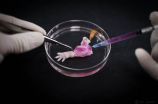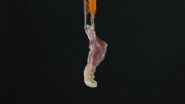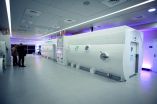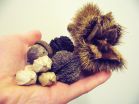(Press-News.org) A team of Massachusetts General Hospital (MGH) investigators has made the first steps towards development of bioartificial replacement limbs suitable for transplantation. In their report, which has been published online in the journal Biomaterials, the researchers describe using an experimental approach previously used to build bioartificial organs to engineer rat forelimbs with functioning vascular and muscle tissue. They also provided evidence that the same approach could be applied to the limbs of primates
"The composite nature of our limbs makes building a functional biological replacement particularly challenging," explains Harald Ott, MD, of the MGH Department of Surgery and the Center for Regenerative Medicine, senior author of the paper. "Limbs contain muscles, bone, cartilage, blood vessels, tendons, ligaments and nerves - each of which has to be rebuilt and requires a specific supporting structure called the matrix. We have shown that we can maintain the matrix of all of these tissues in their natural relationships to each other, that we can culture the entire construct over prolonged periods of time, and that we can repopulate the vascular system and musculature."
The authors note that more than 1.5 million individuals in the U.S. have lost a limb, and although prosthetic technology has greatly advanced, the devices still have many limitations in terms of both function and appearance. Over the past two decades a number of patients have received donor hand transplants, and while such procedures can significantly improve quality of life, they also expose recipients to the risks of life-long immunosuppressive therapy. While the progenitor cells needed to regenerate all of the tissues that make up a limb could be provided by the potential recipient, what has been missing is the matrix or scaffold on which cells could grow into the appropriate tissues.
The current study uses technology Ott discovered as a research fellow at the University of Minnesota, in which living cells are stripped from a donor organ with a detergent solution and the remaining matrix is then repopulated with progenitor cells appropriate to the specific organ. His team and others at MGH and elsewhere have used this decellularization technique to regenerate kidneys, livers, hearts and lungs from animal models, but this is the first reported use to engineer the more complex tissues of a bioartificial limb.
The same decellularization process used in the whole-organ studies - perfusing a detergent solution through the vascular system - was used to strip all cellular materials from forelimbs removed from deceased rats in a way that preserved the primary vasculature and nerve matrix. After thorough removal of cellular debris - a process that took a week - what remained was the cell-free matrix that provides structure to all of a limb's composite tissues. At the same time, populations of muscle and vascular cells were being grown in culture.
The research team then cultured the forelimb matrix in a bioreactor, within which vascular cells were injected into the limb's main artery to regenerate veins and arteries. Muscle progenitors were injected directly into the matrix sheaths that define the position of each muscle. After five days in culture, electrical stimulation was applied to the potential limb graft to further promote muscle formation, and after two weeks, the grafts were removed from the bioreactor. Analysis of the bioartificial limbs confirmed the presence of vascular cells along blood vessel walls and muscle cells aligned into appropriate fibers throughout the muscle matrix.
Functional testing of the isolated limbs showed that electrical stimulation of muscle fibers caused them to contract with a strength 80 percent of what would be seen in newborn animals. The vascular systems of bioengineered forelimbs transplanted into recipient animals quickly filled with blood which continued to circulate, and electrical stimulation of muscles within transplanted grafts flexed the wrists and digital joints of the animals' paws. The research team also successfully decellularized baboon forearms to confirm the feasibility of using this approach on the scale that would be required for human patients.
Ott notes that, while regrowing nerves within a limb graft and reintegrating them into a recipient's nervous system is one of the next challenges that needs to be faced, the experience of patients who have received hand transplants is promising. "In clinical limb transplantation, nerves do grow back into the graft, enabling both motion and sensation, and we have learned that this process is largely guided by the nerve matrix within the graft. We hope in future work to show that the same will apply to bioartificial grafts. Additional next steps will be replicating our success in muscle regeneration with human cells and expanding that to other tissue types, such as bone, cartilage and connective tissue."
INFORMATION:
Ott is an assistant professor of Surgery at Harvard Medical School. Bernhard Jank, MD, of the MGH Center for Regenerative Medicine is lead author of the Biomaterials paper. Additional co-authors are Linjie Xiong, MD, Philipp Moser, MD, Jacques Guyette , PhD, Xi Ren, PhD, and Leopoldo Fernandez, MD, MGH Center for Regenerative Medicine; and Curtis Cetrulo, MD, David Leonard, MBChB, and Shawn Fagan, MD, MGH Department of Surgery. The study was supported by a New Innovator Award from the National Institutes of Health.
Massachusetts General Hospital, founded in 1811, is the original and largest teaching hospital of Harvard Medical School. The MGH conducts the largest hospital-based research program in the United States, with an annual research budget of more than $760 million and major research centers in AIDS, cardiovascular research, cancer, computational and integrative biology, cutaneous biology, human genetics, medical imaging, neurodegenerative disorders, regenerative medicine, reproductive biology, systems biology, transplantation biology and photomedicine.
Who says you can't do two things at once and do them both well?
A new University of Florida study challenges the notion that multi-tasking causes one or both activities to suffer. In a study of older adults who completed cognitive tasks while cycling on a stationary bike, UF researchers found that participants' cycling speed improved while multi-tasking with no cost to their cognitive performance.
Results of the study, which was supported by a grant from the National Institute on Aging, were published May 13 in the journal PLOS ONE.
The discovery was a surprise finding ...
COLUMBUS, Ohio - A new nationwide study reveals that the kind of cities that attract college graduates has changed since the 1990s.
In the 1990s, grads were moving to cities with fast-growing "smart" industries in fields like high tech, the study found. But since 2000, with a less vibrant national economy, college graduates are flocking toward the biggest cities with the biggest labor markets and the best chances of landing a job.
In fact, the effect of city population size in attracting college grads was nearly four times as large in the 2000s as it was in the 1990s, ...
(New York, NY, June 1, 2015)-- The Big Apple is one of the most walkable cities in the nation, providing many opportunities for physical activity, and New Yorkers are more likely to exercise regularly than the average U.S. adult. But they are also sitting far more than what is considered healthy.
According to a new study published by the U.S. Centers for Disease Control and Prevention in its journal Preventing Chronic Disease, the average New York City resident sits more than seven hours a day--greatly exceeding the three hours or more per day that is associated with ...
HOUSTON - (June 2, 2015) - Hispanics and women in Texas showed the largest percentage of reductions in rates of uninsured since enrollment began in the Affordable Care Act's (ACA) Health Insurance Marketplace, according to a new report released today by the Episcopal Health Foundation and Rice University's Baker Institute for Public Policy.
The report found that from September 2013 to March 2015, the percentage of Hispanics without health insurance fell 38 percent (from 39.1 percent uninsured to 24.3 percent), more than any other ethnic group. The percentage of uninsured ...
HOUSTON - (June 2, 2015) - Women who suffer from fibromyalgia benefit from a treatment regimen in a hyperbaric oxygen chamber, according to researchers at Rice University and institutes in Israel.
A clinical trial involving women diagnosed with fibromyalgia showed the painful condition improved in every one of the 48 who completed two months of hyperbaric oxygen therapy. Brain scans of the women before and after treatment gave credence to the theory that abnormal conditions in pain-related areas of the brain may be responsible for the syndrome.
Results of the study ...
BUFFALO, N.Y. -- A new study by University at Buffalo geographers explores how humans altered the arboreal make-up of Western New York forests before European settlers arrived in large numbers.
The research looked at land survey data from around 1799-1814, and used this information to model which tree species were present in different areas of Chautauqua County, New York, at that time.
The analysis placed hickory, chestnut and oak trees in larger-than-expected numbers near the historical sites of Native American villages, said co-author Steve Tulowiecki, who conducted ...
MAYWOOD, Ill. - Drawing on its Jesuit Catholic heritage, Loyola University Chicago Stritch School of Medicine has long understood the importance of reflection in medical education as a key element in physician formation. With physician burnout on the rise, it is all the more integral for students to learn ways to engage better with the challenges faced in the medical profession. Stritch faculty members believe reflection is a fundamental tool to help students process and cope with the tremendous physical, emotional, and mental pressure that can accompany their vocation.
These ...
Hamilton, ON (June 2, 2015) - What causes us to lose muscle strength as we age and how exercise can prevent it from happening has never been thoroughly understood, but McMaster University researchers have discovered a key protein required to maintain muscle mass and muscle strength during aging.
This important finding means new and existing drugs targeting the protein may potentially be used to preserve muscle function during aging.
"We found that the body's fuel gauge, AMP-activated protein kinase (AMPK), is vital to slow muscle wasting with aging," said Gregory Steinberg, ...
Researchers of the Luxembourg Centre for Systems Biomedicine (LCSB) of the University of Luxembourg have discovered with the help of computer models how gut bacteria respond to changes in their environment - such as a decrease in oxygen levels or nutrient availability. Microorganisms that normally compete or overthrow one another can switch to a cooperative lifestyle when their living conditions change: They even start producing substances to make life easier for the other species, helping them to survive. The entire microbial community then stabilises - and together adapts ...
New Orleans, Louisiana - June 1, 2015 - The skin microbiome is considered our first line of defense against pathogens. Across our bodies, we are covered with a diverse assemblage of bacteria. However, the skin can be a harsh environment for beneficial bacteria to live on due to UV exposure, high salinity, and desiccation stress. Research being presented at the annual meeting of the American Society for Microbiology found that these suboptimal conditions may cause some bacteria to enter a dormant state, while other bacteria may simply die.
In this study, Sarah Cummins ...




